Lead and Manage People: Leadership, Communication, and Planning Skills
VerifiedAdded on 2020/05/28
|49
|9157
|155
Homework Assignment
AI Summary
This assignment explores various aspects of leading and managing people. It begins by defining the qualities of an effective leader and the importance of role modeling, including establishing positive group norms and ethical behavior. The assignment then delves into communication skills, emphasizing empathy, clear messaging, and strategies to overcome communication barriers. Furthermore, it covers organizational planning, different types of plans, and the importance of involving team members in goal setting. The document addresses leadership styles (directive, participative, and laissez-faire) and their appropriate applications. It also discusses the importance of fairness, organizational justice, and resource management. The assignment concludes with strategies for maintaining energy, commitment, and developing leadership skills, providing a comprehensive overview of the core elements of effective leadership and management.
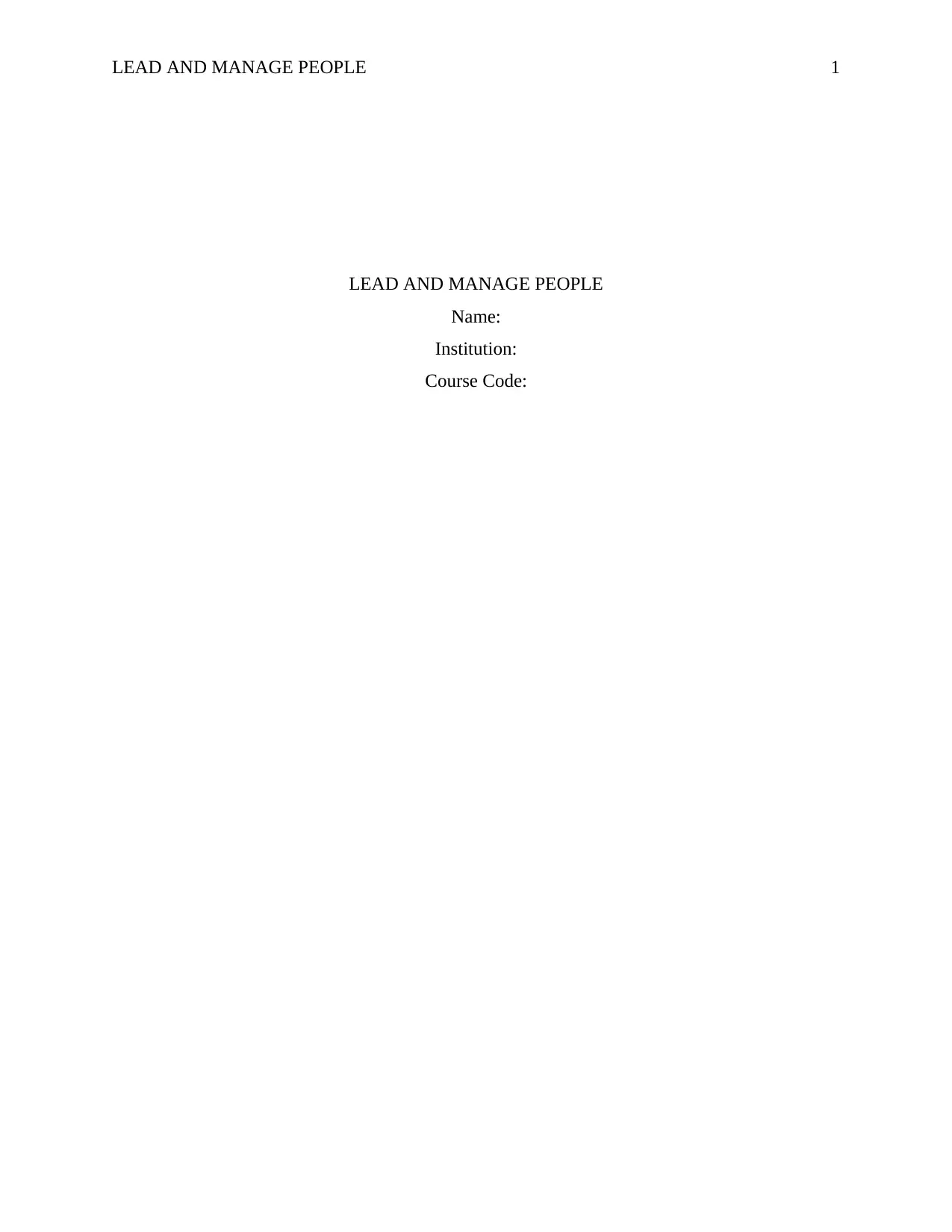
LEAD AND MANAGE PEOPLE 1
LEAD AND MANAGE PEOPLE
Name:
Institution:
Course Code:
LEAD AND MANAGE PEOPLE
Name:
Institution:
Course Code:
Paraphrase This Document
Need a fresh take? Get an instant paraphrase of this document with our AI Paraphraser

LEAD AND MANAGE PEOPLE 2
ASSESSMENT C2 PART A – PRACTICAL DEMONSTRATION
ASSESSMENT C2 PART A – PRACTICAL DEMONSTRATION
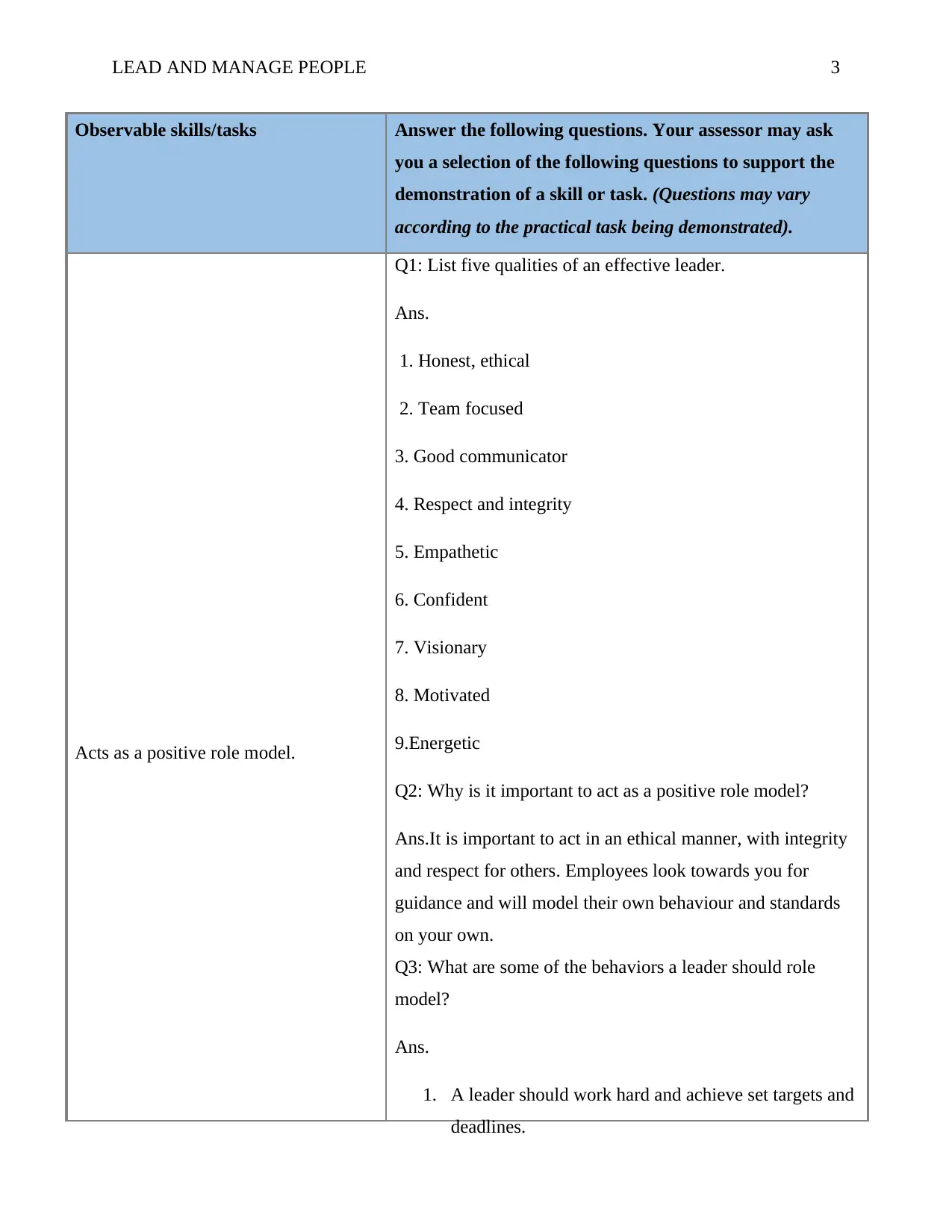
LEAD AND MANAGE PEOPLE 3
Observable skills/tasks Answer the following questions. Your assessor may ask
you a selection of the following questions to support the
demonstration of a skill or task. (Questions may vary
according to the practical task being demonstrated).
Acts as a positive role model.
Q1: List five qualities of an effective leader.
Ans.
1. Honest, ethical
2. Team focused
3. Good communicator
4. Respect and integrity
5. Empathetic
6. Confident
7. Visionary
8. Motivated
9.Energetic
Q2: Why is it important to act as a positive role model?
Ans.It is important to act in an ethical manner, with integrity
and respect for others. Employees look towards you for
guidance and will model their own behaviour and standards
on your own.
Q3: What are some of the behaviors a leader should role
model?
Ans.
1. A leader should work hard and achieve set targets and
deadlines.
Observable skills/tasks Answer the following questions. Your assessor may ask
you a selection of the following questions to support the
demonstration of a skill or task. (Questions may vary
according to the practical task being demonstrated).
Acts as a positive role model.
Q1: List five qualities of an effective leader.
Ans.
1. Honest, ethical
2. Team focused
3. Good communicator
4. Respect and integrity
5. Empathetic
6. Confident
7. Visionary
8. Motivated
9.Energetic
Q2: Why is it important to act as a positive role model?
Ans.It is important to act in an ethical manner, with integrity
and respect for others. Employees look towards you for
guidance and will model their own behaviour and standards
on your own.
Q3: What are some of the behaviors a leader should role
model?
Ans.
1. A leader should work hard and achieve set targets and
deadlines.
⊘ This is a preview!⊘
Do you want full access?
Subscribe today to unlock all pages.

Trusted by 1+ million students worldwide
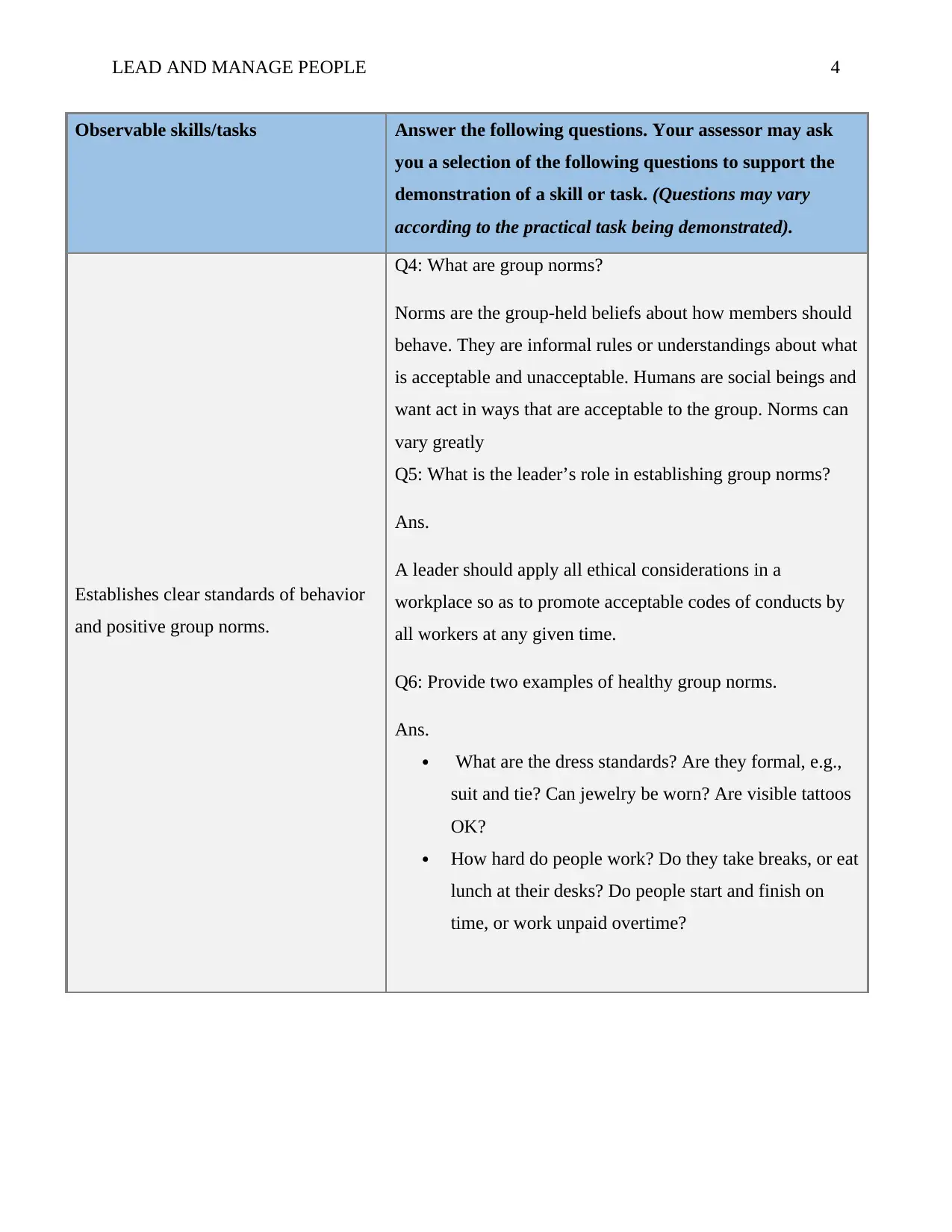
LEAD AND MANAGE PEOPLE 4
Observable skills/tasks Answer the following questions. Your assessor may ask
you a selection of the following questions to support the
demonstration of a skill or task. (Questions may vary
according to the practical task being demonstrated).
Establishes clear standards of behavior
and positive group norms.
Q4: What are group norms?
Norms are the group-held beliefs about how members should
behave. They are informal rules or understandings about what
is acceptable and unacceptable. Humans are social beings and
want act in ways that are acceptable to the group. Norms can
vary greatly
Q5: What is the leader’s role in establishing group norms?
Ans.
A leader should apply all ethical considerations in a
workplace so as to promote acceptable codes of conducts by
all workers at any given time.
Q6: Provide two examples of healthy group norms.
Ans.
What are the dress standards? Are they formal, e.g.,
suit and tie? Can jewelry be worn? Are visible tattoos
OK?
How hard do people work? Do they take breaks, or eat
lunch at their desks? Do people start and finish on
time, or work unpaid overtime?
Observable skills/tasks Answer the following questions. Your assessor may ask
you a selection of the following questions to support the
demonstration of a skill or task. (Questions may vary
according to the practical task being demonstrated).
Establishes clear standards of behavior
and positive group norms.
Q4: What are group norms?
Norms are the group-held beliefs about how members should
behave. They are informal rules or understandings about what
is acceptable and unacceptable. Humans are social beings and
want act in ways that are acceptable to the group. Norms can
vary greatly
Q5: What is the leader’s role in establishing group norms?
Ans.
A leader should apply all ethical considerations in a
workplace so as to promote acceptable codes of conducts by
all workers at any given time.
Q6: Provide two examples of healthy group norms.
Ans.
What are the dress standards? Are they formal, e.g.,
suit and tie? Can jewelry be worn? Are visible tattoos
OK?
How hard do people work? Do they take breaks, or eat
lunch at their desks? Do people start and finish on
time, or work unpaid overtime?
Paraphrase This Document
Need a fresh take? Get an instant paraphrase of this document with our AI Paraphraser
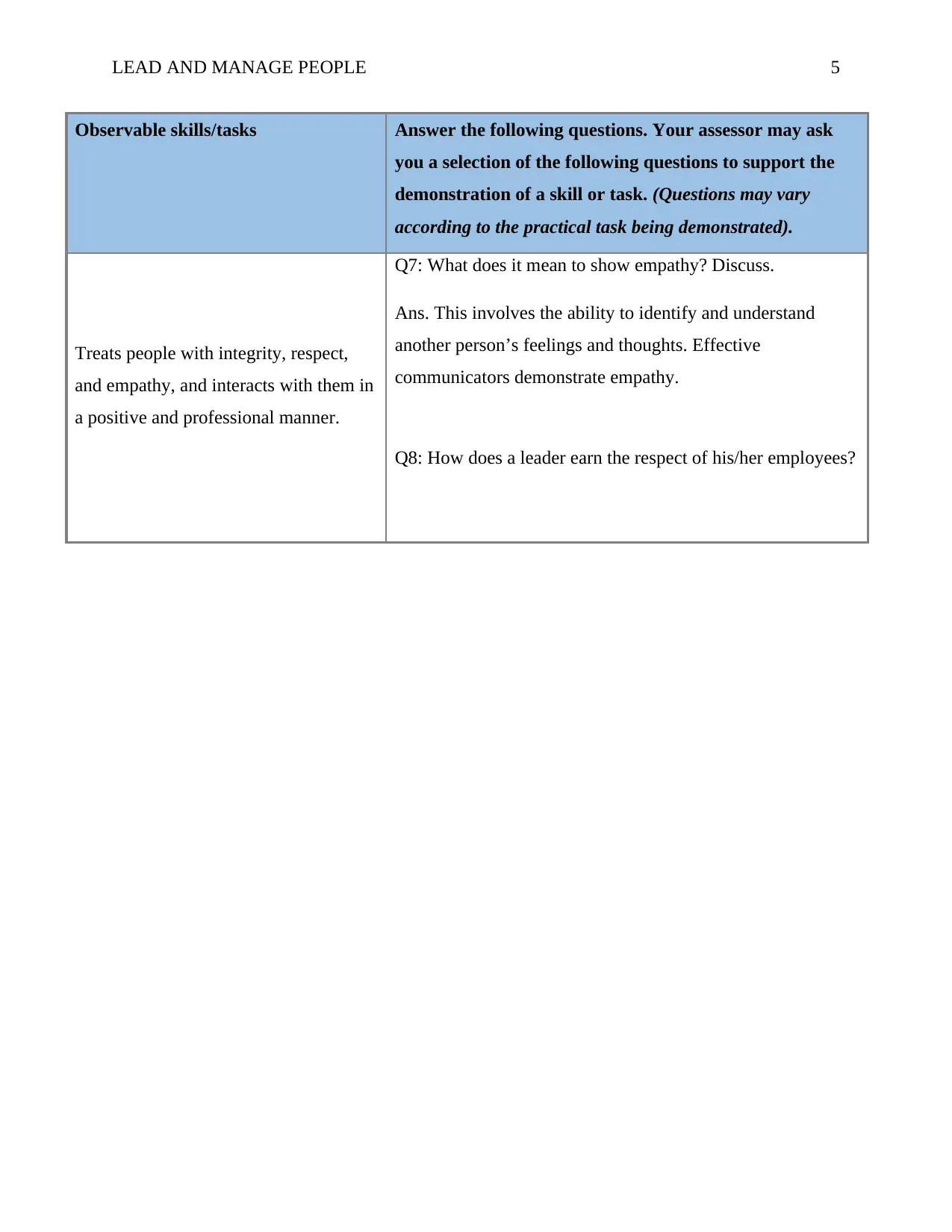
LEAD AND MANAGE PEOPLE 5
Observable skills/tasks Answer the following questions. Your assessor may ask
you a selection of the following questions to support the
demonstration of a skill or task. (Questions may vary
according to the practical task being demonstrated).
Treats people with integrity, respect,
and empathy, and interacts with them in
a positive and professional manner.
Q7: What does it mean to show empathy? Discuss.
Ans. This involves the ability to identify and understand
another person’s feelings and thoughts. Effective
communicators demonstrate empathy.
Q8: How does a leader earn the respect of his/her employees?
Observable skills/tasks Answer the following questions. Your assessor may ask
you a selection of the following questions to support the
demonstration of a skill or task. (Questions may vary
according to the practical task being demonstrated).
Treats people with integrity, respect,
and empathy, and interacts with them in
a positive and professional manner.
Q7: What does it mean to show empathy? Discuss.
Ans. This involves the ability to identify and understand
another person’s feelings and thoughts. Effective
communicators demonstrate empathy.
Q8: How does a leader earn the respect of his/her employees?
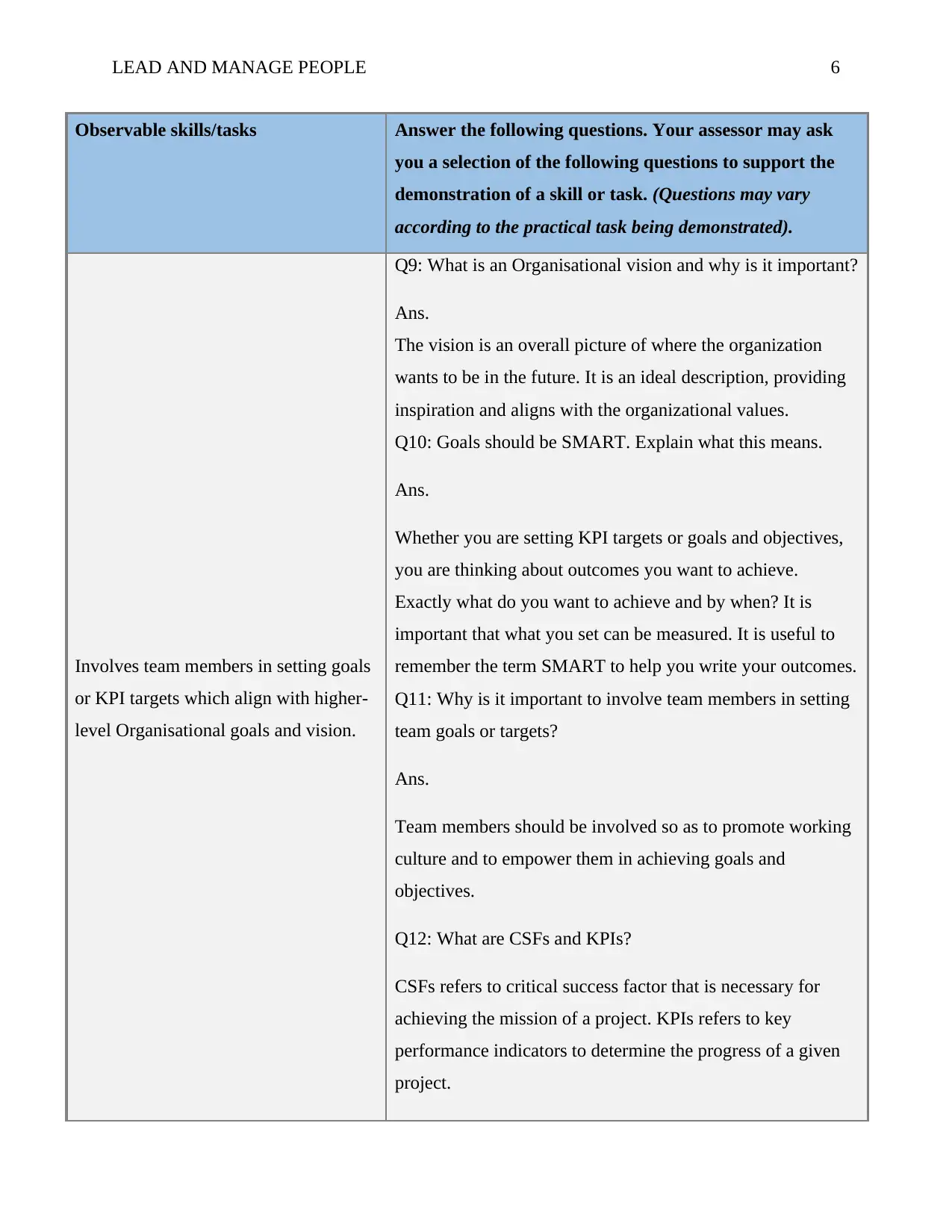
LEAD AND MANAGE PEOPLE 6
Observable skills/tasks Answer the following questions. Your assessor may ask
you a selection of the following questions to support the
demonstration of a skill or task. (Questions may vary
according to the practical task being demonstrated).
Involves team members in setting goals
or KPI targets which align with higher-
level Organisational goals and vision.
Q9: What is an Organisational vision and why is it important?
Ans.
The vision is an overall picture of where the organization
wants to be in the future. It is an ideal description, providing
inspiration and aligns with the organizational values.
Q10: Goals should be SMART. Explain what this means.
Ans.
Whether you are setting KPI targets or goals and objectives,
you are thinking about outcomes you want to achieve.
Exactly what do you want to achieve and by when? It is
important that what you set can be measured. It is useful to
remember the term SMART to help you write your outcomes.
Q11: Why is it important to involve team members in setting
team goals or targets?
Ans.
Team members should be involved so as to promote working
culture and to empower them in achieving goals and
objectives.
Q12: What are CSFs and KPIs?
CSFs refers to critical success factor that is necessary for
achieving the mission of a project. KPIs refers to key
performance indicators to determine the progress of a given
project.
Observable skills/tasks Answer the following questions. Your assessor may ask
you a selection of the following questions to support the
demonstration of a skill or task. (Questions may vary
according to the practical task being demonstrated).
Involves team members in setting goals
or KPI targets which align with higher-
level Organisational goals and vision.
Q9: What is an Organisational vision and why is it important?
Ans.
The vision is an overall picture of where the organization
wants to be in the future. It is an ideal description, providing
inspiration and aligns with the organizational values.
Q10: Goals should be SMART. Explain what this means.
Ans.
Whether you are setting KPI targets or goals and objectives,
you are thinking about outcomes you want to achieve.
Exactly what do you want to achieve and by when? It is
important that what you set can be measured. It is useful to
remember the term SMART to help you write your outcomes.
Q11: Why is it important to involve team members in setting
team goals or targets?
Ans.
Team members should be involved so as to promote working
culture and to empower them in achieving goals and
objectives.
Q12: What are CSFs and KPIs?
CSFs refers to critical success factor that is necessary for
achieving the mission of a project. KPIs refers to key
performance indicators to determine the progress of a given
project.
⊘ This is a preview!⊘
Do you want full access?
Subscribe today to unlock all pages.

Trusted by 1+ million students worldwide
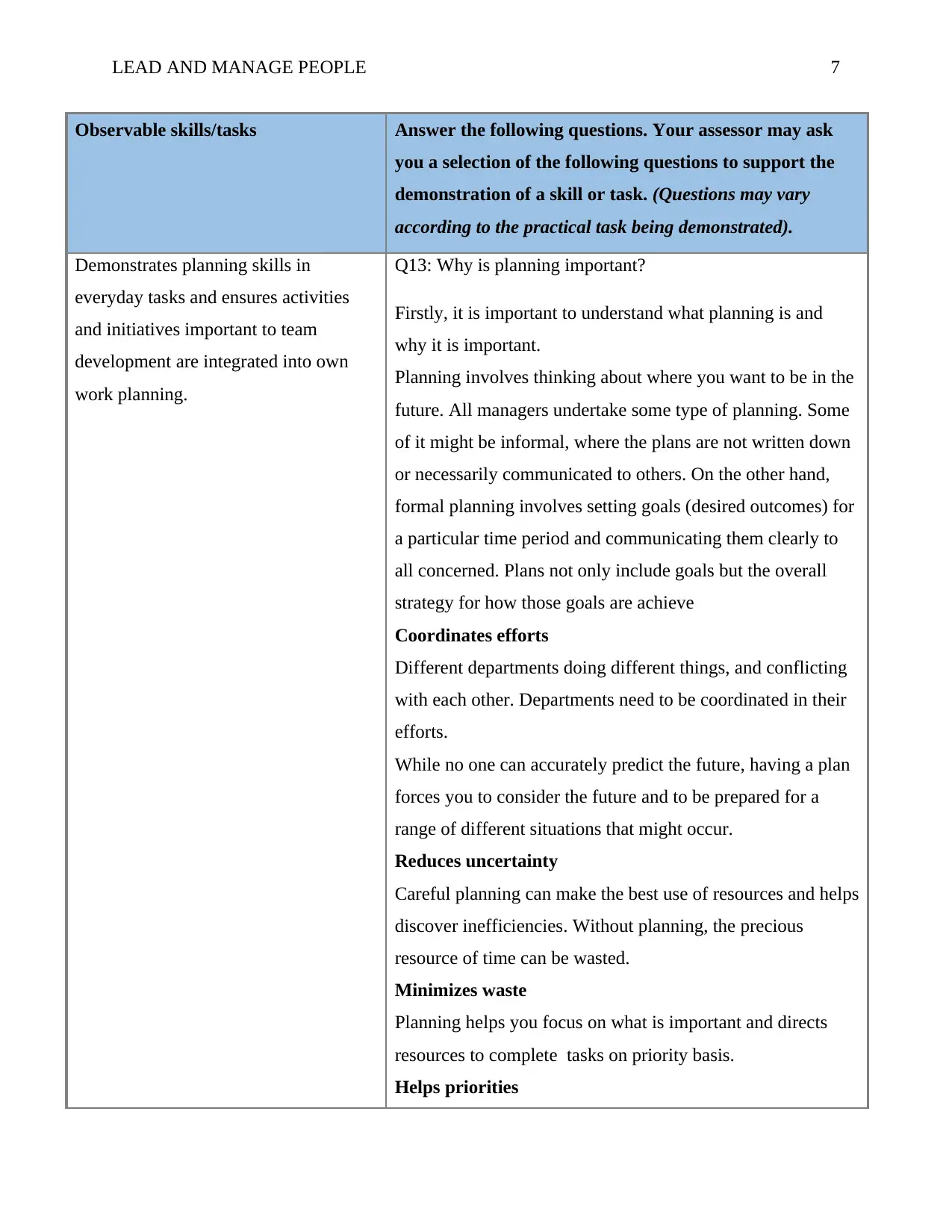
LEAD AND MANAGE PEOPLE 7
Observable skills/tasks Answer the following questions. Your assessor may ask
you a selection of the following questions to support the
demonstration of a skill or task. (Questions may vary
according to the practical task being demonstrated).
Demonstrates planning skills in
everyday tasks and ensures activities
and initiatives important to team
development are integrated into own
work planning.
Q13: Why is planning important?
Firstly, it is important to understand what planning is and
why it is important.
Planning involves thinking about where you want to be in the
future. All managers undertake some type of planning. Some
of it might be informal, where the plans are not written down
or necessarily communicated to others. On the other hand,
formal planning involves setting goals (desired outcomes) for
a particular time period and communicating them clearly to
all concerned. Plans not only include goals but the overall
strategy for how those goals are achieve
Coordinates efforts
Different departments doing different things, and conflicting
with each other. Departments need to be coordinated in their
efforts.
While no one can accurately predict the future, having a plan
forces you to consider the future and to be prepared for a
range of different situations that might occur.
Reduces uncertainty
Careful planning can make the best use of resources and helps
discover inefficiencies. Without planning, the precious
resource of time can be wasted.
Minimizes waste
Planning helps you focus on what is important and directs
resources to complete tasks on priority basis.
Helps priorities
Observable skills/tasks Answer the following questions. Your assessor may ask
you a selection of the following questions to support the
demonstration of a skill or task. (Questions may vary
according to the practical task being demonstrated).
Demonstrates planning skills in
everyday tasks and ensures activities
and initiatives important to team
development are integrated into own
work planning.
Q13: Why is planning important?
Firstly, it is important to understand what planning is and
why it is important.
Planning involves thinking about where you want to be in the
future. All managers undertake some type of planning. Some
of it might be informal, where the plans are not written down
or necessarily communicated to others. On the other hand,
formal planning involves setting goals (desired outcomes) for
a particular time period and communicating them clearly to
all concerned. Plans not only include goals but the overall
strategy for how those goals are achieve
Coordinates efforts
Different departments doing different things, and conflicting
with each other. Departments need to be coordinated in their
efforts.
While no one can accurately predict the future, having a plan
forces you to consider the future and to be prepared for a
range of different situations that might occur.
Reduces uncertainty
Careful planning can make the best use of resources and helps
discover inefficiencies. Without planning, the precious
resource of time can be wasted.
Minimizes waste
Planning helps you focus on what is important and directs
resources to complete tasks on priority basis.
Helps priorities
Paraphrase This Document
Need a fresh take? Get an instant paraphrase of this document with our AI Paraphraser
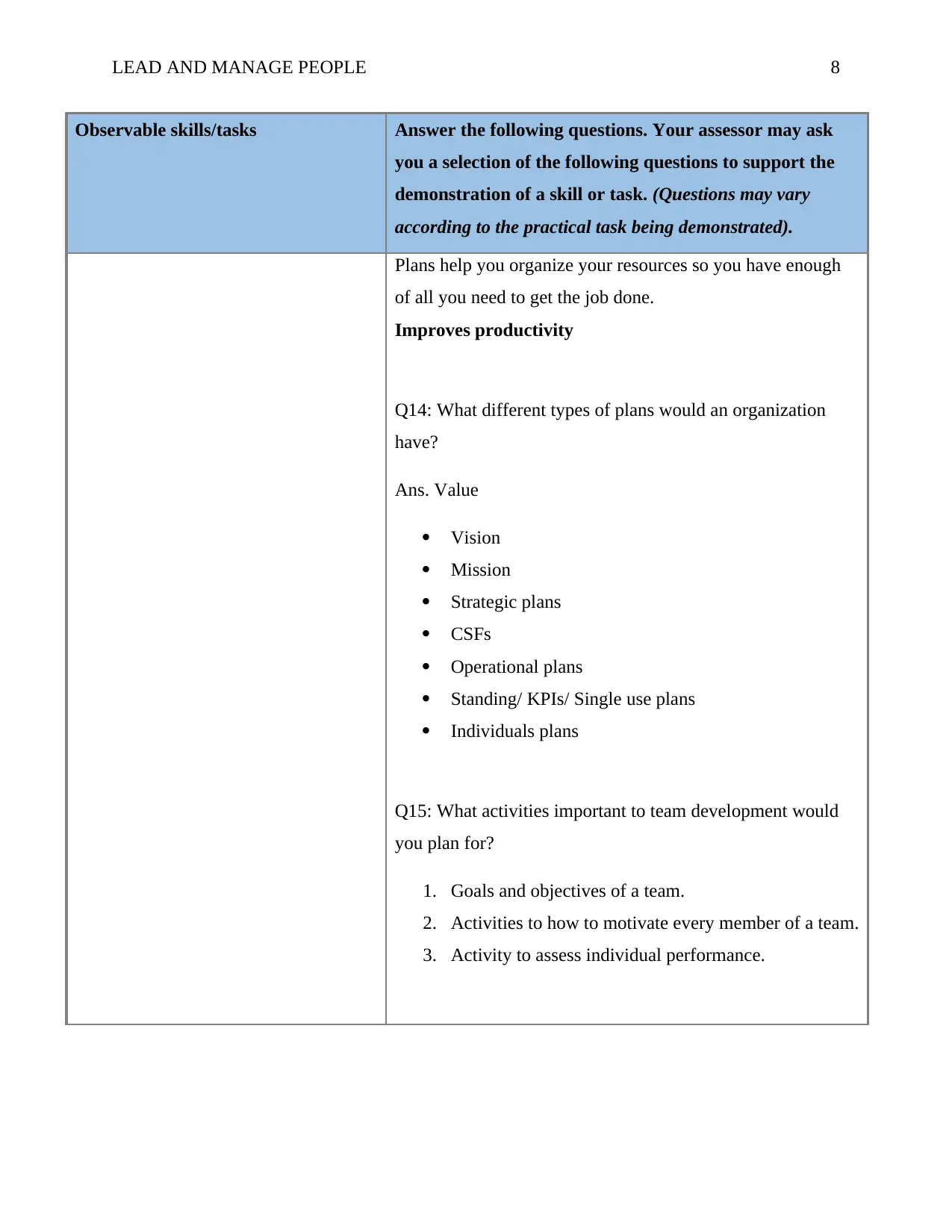
LEAD AND MANAGE PEOPLE 8
Observable skills/tasks Answer the following questions. Your assessor may ask
you a selection of the following questions to support the
demonstration of a skill or task. (Questions may vary
according to the practical task being demonstrated).
Plans help you organize your resources so you have enough
of all you need to get the job done.
Improves productivity
Q14: What different types of plans would an organization
have?
Ans. Value
Vision
Mission
Strategic plans
CSFs
Operational plans
Standing/ KPIs/ Single use plans
Individuals plans
Q15: What activities important to team development would
you plan for?
1. Goals and objectives of a team.
2. Activities to how to motivate every member of a team.
3. Activity to assess individual performance.
Observable skills/tasks Answer the following questions. Your assessor may ask
you a selection of the following questions to support the
demonstration of a skill or task. (Questions may vary
according to the practical task being demonstrated).
Plans help you organize your resources so you have enough
of all you need to get the job done.
Improves productivity
Q14: What different types of plans would an organization
have?
Ans. Value
Vision
Mission
Strategic plans
CSFs
Operational plans
Standing/ KPIs/ Single use plans
Individuals plans
Q15: What activities important to team development would
you plan for?
1. Goals and objectives of a team.
2. Activities to how to motivate every member of a team.
3. Activity to assess individual performance.
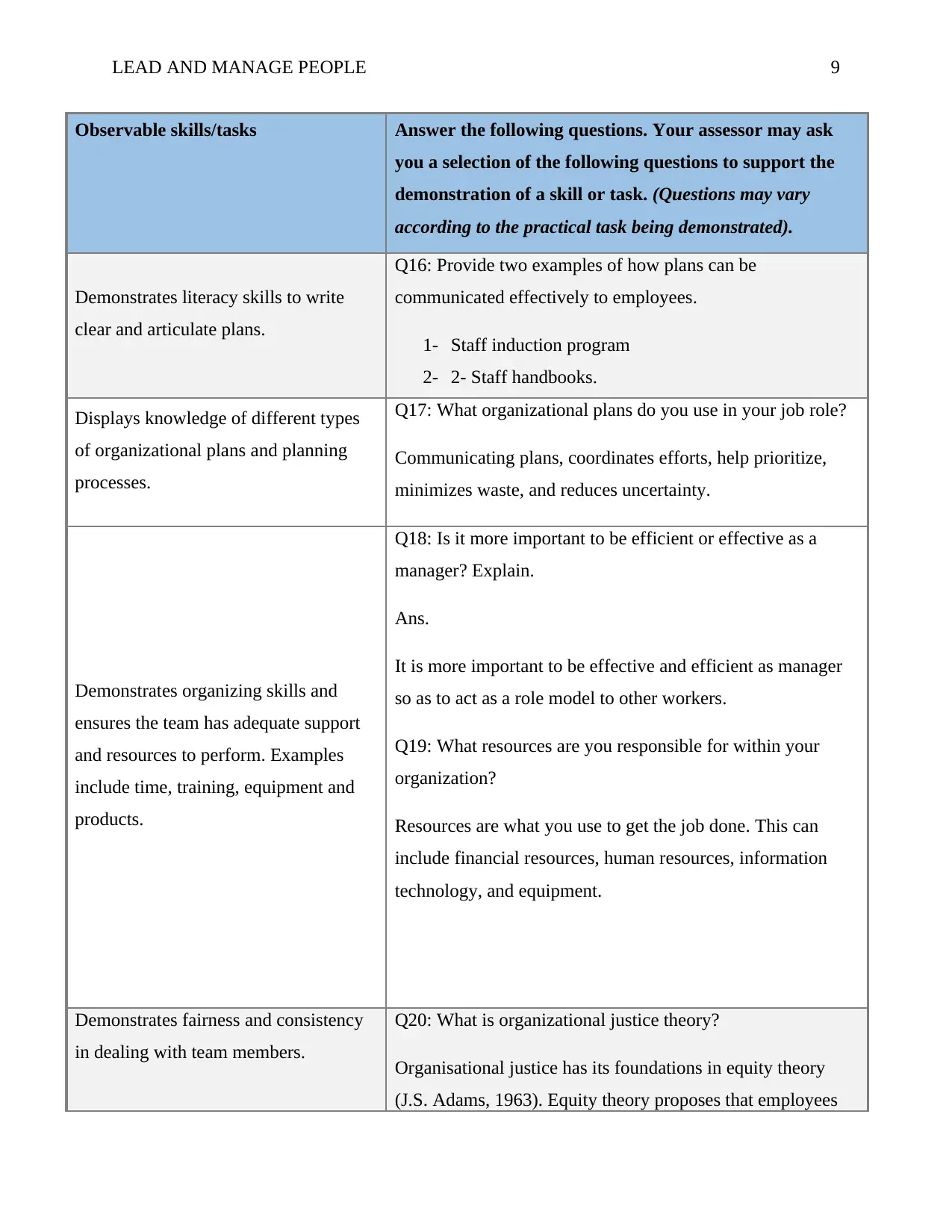
LEAD AND MANAGE PEOPLE 9
Observable skills/tasks Answer the following questions. Your assessor may ask
you a selection of the following questions to support the
demonstration of a skill or task. (Questions may vary
according to the practical task being demonstrated).
Demonstrates literacy skills to write
clear and articulate plans.
Q16: Provide two examples of how plans can be
communicated effectively to employees.
1- Staff induction program
2- 2- Staff handbooks.
Displays knowledge of different types
of organizational plans and planning
processes.
Q17: What organizational plans do you use in your job role?
Communicating plans, coordinates efforts, help prioritize,
minimizes waste, and reduces uncertainty.
Demonstrates organizing skills and
ensures the team has adequate support
and resources to perform. Examples
include time, training, equipment and
products.
Q18: Is it more important to be efficient or effective as a
manager? Explain.
Ans.
It is more important to be effective and efficient as manager
so as to act as a role model to other workers.
Q19: What resources are you responsible for within your
organization?
Resources are what you use to get the job done. This can
include financial resources, human resources, information
technology, and equipment.
Demonstrates fairness and consistency
in dealing with team members.
Q20: What is organizational justice theory?
Organisational justice has its foundations in equity theory
(J.S. Adams, 1963). Equity theory proposes that employees
Observable skills/tasks Answer the following questions. Your assessor may ask
you a selection of the following questions to support the
demonstration of a skill or task. (Questions may vary
according to the practical task being demonstrated).
Demonstrates literacy skills to write
clear and articulate plans.
Q16: Provide two examples of how plans can be
communicated effectively to employees.
1- Staff induction program
2- 2- Staff handbooks.
Displays knowledge of different types
of organizational plans and planning
processes.
Q17: What organizational plans do you use in your job role?
Communicating plans, coordinates efforts, help prioritize,
minimizes waste, and reduces uncertainty.
Demonstrates organizing skills and
ensures the team has adequate support
and resources to perform. Examples
include time, training, equipment and
products.
Q18: Is it more important to be efficient or effective as a
manager? Explain.
Ans.
It is more important to be effective and efficient as manager
so as to act as a role model to other workers.
Q19: What resources are you responsible for within your
organization?
Resources are what you use to get the job done. This can
include financial resources, human resources, information
technology, and equipment.
Demonstrates fairness and consistency
in dealing with team members.
Q20: What is organizational justice theory?
Organisational justice has its foundations in equity theory
(J.S. Adams, 1963). Equity theory proposes that employees
⊘ This is a preview!⊘
Do you want full access?
Subscribe today to unlock all pages.

Trusted by 1+ million students worldwide
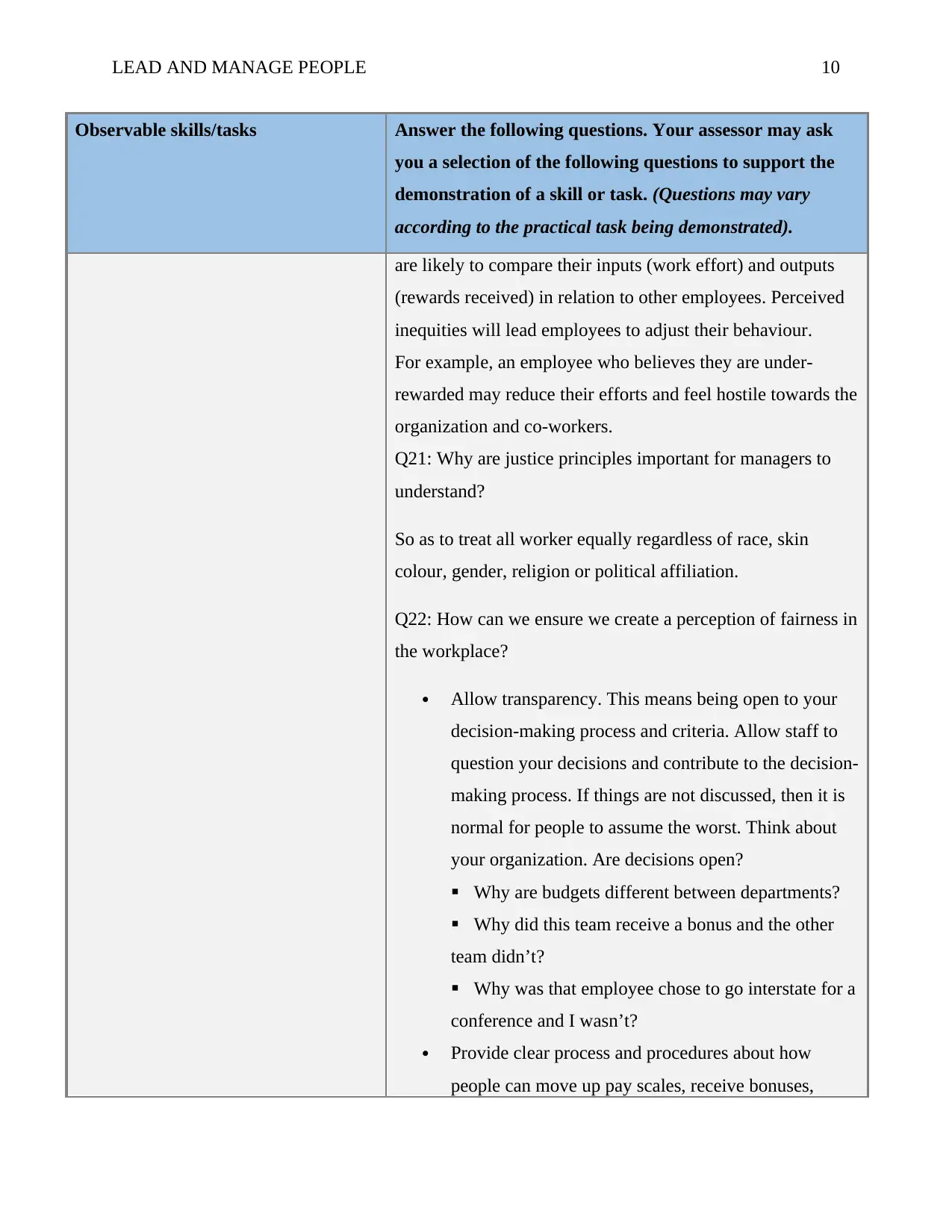
LEAD AND MANAGE PEOPLE 10
Observable skills/tasks Answer the following questions. Your assessor may ask
you a selection of the following questions to support the
demonstration of a skill or task. (Questions may vary
according to the practical task being demonstrated).
are likely to compare their inputs (work effort) and outputs
(rewards received) in relation to other employees. Perceived
inequities will lead employees to adjust their behaviour.
For example, an employee who believes they are under-
rewarded may reduce their efforts and feel hostile towards the
organization and co-workers.
Q21: Why are justice principles important for managers to
understand?
So as to treat all worker equally regardless of race, skin
colour, gender, religion or political affiliation.
Q22: How can we ensure we create a perception of fairness in
the workplace?
Allow transparency. This means being open to your
decision-making process and criteria. Allow staff to
question your decisions and contribute to the decision-
making process. If things are not discussed, then it is
normal for people to assume the worst. Think about
your organization. Are decisions open?
Why are budgets different between departments?
Why did this team receive a bonus and the other
team didn’t?
Why was that employee chose to go interstate for a
conference and I wasn’t?
Provide clear process and procedures about how
people can move up pay scales, receive bonuses,
Observable skills/tasks Answer the following questions. Your assessor may ask
you a selection of the following questions to support the
demonstration of a skill or task. (Questions may vary
according to the practical task being demonstrated).
are likely to compare their inputs (work effort) and outputs
(rewards received) in relation to other employees. Perceived
inequities will lead employees to adjust their behaviour.
For example, an employee who believes they are under-
rewarded may reduce their efforts and feel hostile towards the
organization and co-workers.
Q21: Why are justice principles important for managers to
understand?
So as to treat all worker equally regardless of race, skin
colour, gender, religion or political affiliation.
Q22: How can we ensure we create a perception of fairness in
the workplace?
Allow transparency. This means being open to your
decision-making process and criteria. Allow staff to
question your decisions and contribute to the decision-
making process. If things are not discussed, then it is
normal for people to assume the worst. Think about
your organization. Are decisions open?
Why are budgets different between departments?
Why did this team receive a bonus and the other
team didn’t?
Why was that employee chose to go interstate for a
conference and I wasn’t?
Provide clear process and procedures about how
people can move up pay scales, receive bonuses,
Paraphrase This Document
Need a fresh take? Get an instant paraphrase of this document with our AI Paraphraser
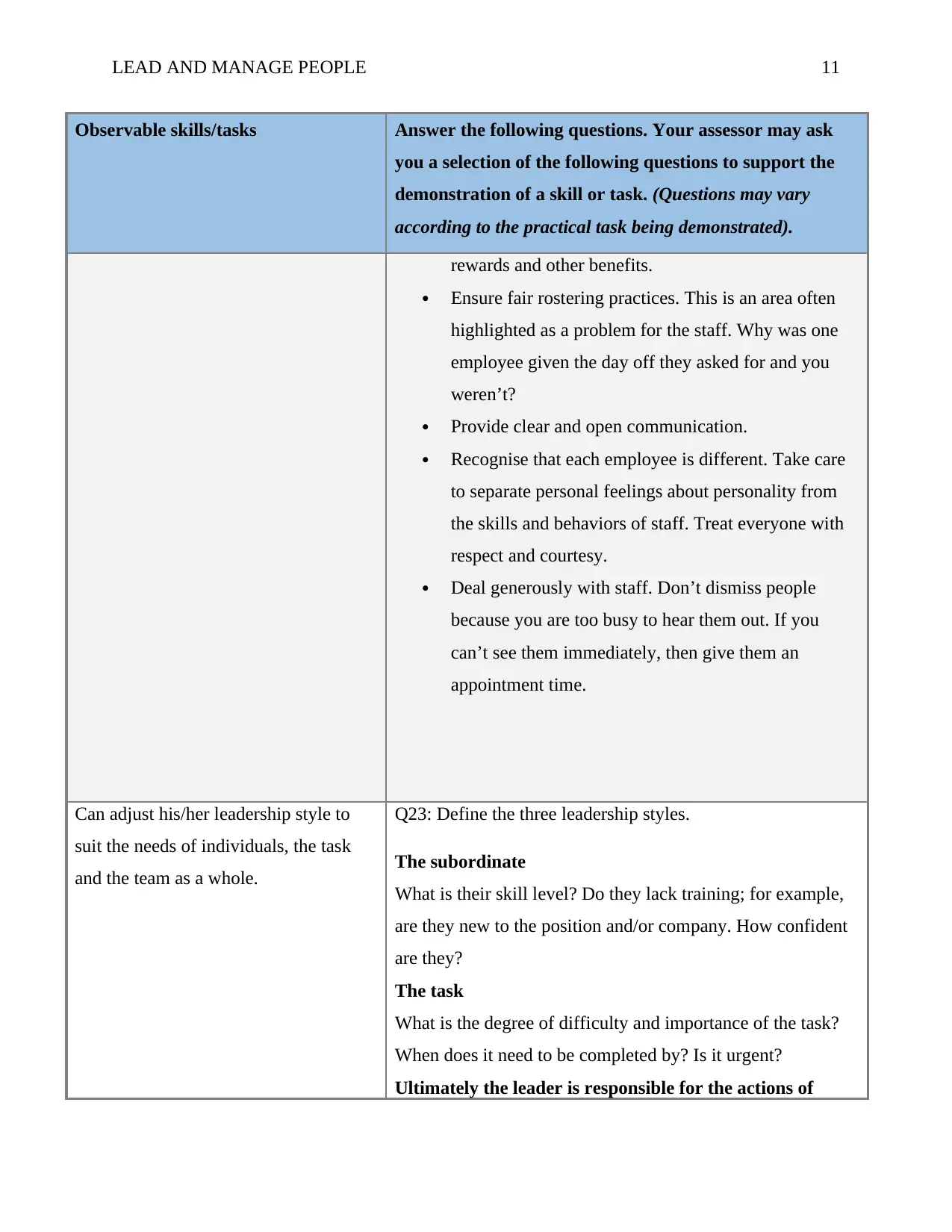
LEAD AND MANAGE PEOPLE 11
Observable skills/tasks Answer the following questions. Your assessor may ask
you a selection of the following questions to support the
demonstration of a skill or task. (Questions may vary
according to the practical task being demonstrated).
rewards and other benefits.
Ensure fair rostering practices. This is an area often
highlighted as a problem for the staff. Why was one
employee given the day off they asked for and you
weren’t?
Provide clear and open communication.
Recognise that each employee is different. Take care
to separate personal feelings about personality from
the skills and behaviors of staff. Treat everyone with
respect and courtesy.
Deal generously with staff. Don’t dismiss people
because you are too busy to hear them out. If you
can’t see them immediately, then give them an
appointment time.
Can adjust his/her leadership style to
suit the needs of individuals, the task
and the team as a whole.
Q23: Define the three leadership styles.
The subordinate
What is their skill level? Do they lack training; for example,
are they new to the position and/or company. How confident
are they?
The task
What is the degree of difficulty and importance of the task?
When does it need to be completed by? Is it urgent?
Ultimately the leader is responsible for the actions of
Observable skills/tasks Answer the following questions. Your assessor may ask
you a selection of the following questions to support the
demonstration of a skill or task. (Questions may vary
according to the practical task being demonstrated).
rewards and other benefits.
Ensure fair rostering practices. This is an area often
highlighted as a problem for the staff. Why was one
employee given the day off they asked for and you
weren’t?
Provide clear and open communication.
Recognise that each employee is different. Take care
to separate personal feelings about personality from
the skills and behaviors of staff. Treat everyone with
respect and courtesy.
Deal generously with staff. Don’t dismiss people
because you are too busy to hear them out. If you
can’t see them immediately, then give them an
appointment time.
Can adjust his/her leadership style to
suit the needs of individuals, the task
and the team as a whole.
Q23: Define the three leadership styles.
The subordinate
What is their skill level? Do they lack training; for example,
are they new to the position and/or company. How confident
are they?
The task
What is the degree of difficulty and importance of the task?
When does it need to be completed by? Is it urgent?
Ultimately the leader is responsible for the actions of
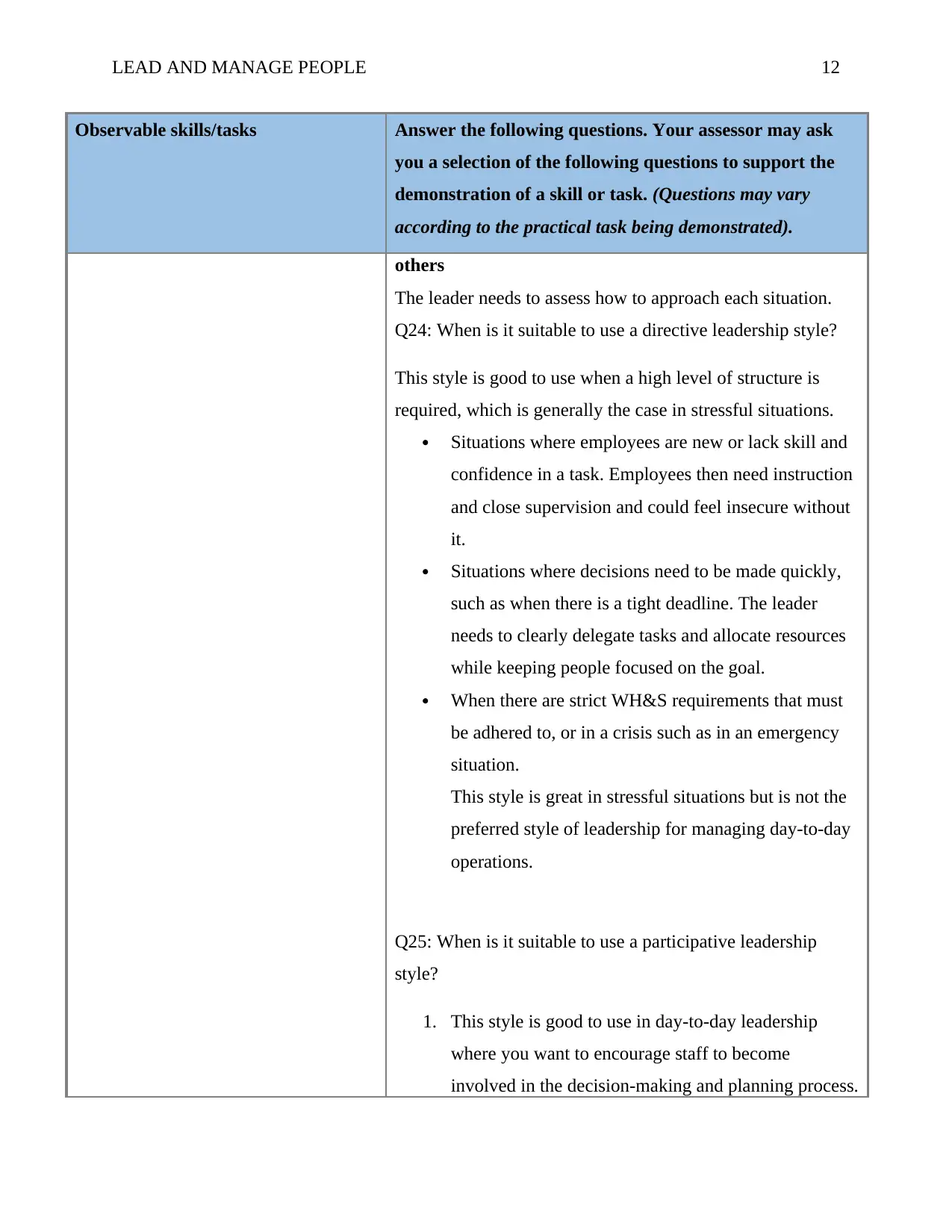
LEAD AND MANAGE PEOPLE 12
Observable skills/tasks Answer the following questions. Your assessor may ask
you a selection of the following questions to support the
demonstration of a skill or task. (Questions may vary
according to the practical task being demonstrated).
others
The leader needs to assess how to approach each situation.
Q24: When is it suitable to use a directive leadership style?
This style is good to use when a high level of structure is
required, which is generally the case in stressful situations.
Situations where employees are new or lack skill and
confidence in a task. Employees then need instruction
and close supervision and could feel insecure without
it.
Situations where decisions need to be made quickly,
such as when there is a tight deadline. The leader
needs to clearly delegate tasks and allocate resources
while keeping people focused on the goal.
When there are strict WH&S requirements that must
be adhered to, or in a crisis such as in an emergency
situation.
This style is great in stressful situations but is not the
preferred style of leadership for managing day-to-day
operations.
Q25: When is it suitable to use a participative leadership
style?
1. This style is good to use in day-to-day leadership
where you want to encourage staff to become
involved in the decision-making and planning process.
Observable skills/tasks Answer the following questions. Your assessor may ask
you a selection of the following questions to support the
demonstration of a skill or task. (Questions may vary
according to the practical task being demonstrated).
others
The leader needs to assess how to approach each situation.
Q24: When is it suitable to use a directive leadership style?
This style is good to use when a high level of structure is
required, which is generally the case in stressful situations.
Situations where employees are new or lack skill and
confidence in a task. Employees then need instruction
and close supervision and could feel insecure without
it.
Situations where decisions need to be made quickly,
such as when there is a tight deadline. The leader
needs to clearly delegate tasks and allocate resources
while keeping people focused on the goal.
When there are strict WH&S requirements that must
be adhered to, or in a crisis such as in an emergency
situation.
This style is great in stressful situations but is not the
preferred style of leadership for managing day-to-day
operations.
Q25: When is it suitable to use a participative leadership
style?
1. This style is good to use in day-to-day leadership
where you want to encourage staff to become
involved in the decision-making and planning process.
⊘ This is a preview!⊘
Do you want full access?
Subscribe today to unlock all pages.

Trusted by 1+ million students worldwide
1 out of 49
Related Documents
Your All-in-One AI-Powered Toolkit for Academic Success.
+13062052269
info@desklib.com
Available 24*7 on WhatsApp / Email
![[object Object]](/_next/static/media/star-bottom.7253800d.svg)
Unlock your academic potential
Copyright © 2020–2025 A2Z Services. All Rights Reserved. Developed and managed by ZUCOL.





